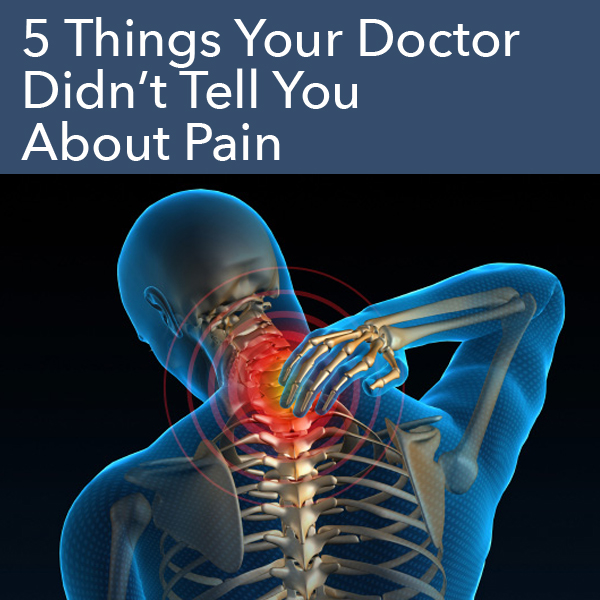Often I spend a good portion of time in my initial exam educating patients on their condition. The root of the word “doctor” means “teacher”, and I take that role seriously. I believe that if a patient understands their problem, they’ll play a cooperative role in the solution.
But frequently these conversations illuminate a different problem. Most people have no idea about the very basic nature of pain. Misunderstanding abounds. And confusion leads to muddled results. Because when we don’t understand the underlying root causes of pain and dysfunction, we can’t act in our best interest.
Here are 5 ways I hope to clarify this thing we call pain:
1. Pain is a good thing
2. Pain is in the brain
3. Pain is a symptom, not a diagnosis
4. Pain is often the last symptom to show up and first to go away
5. Pain should not be ignored
Pain is a good thing
Easy to say when you’re not suffering! But pain is one of our most important adaptations. It tells us something is wrong and forces us to take action. Without a symptom like pain, many serious health issues would go unnoticed and lead to more serious problems or even premature expiration.
Pain is in the brain
The main control center for receiving pain signals in the brain is called the thalamus. It’s more than simply a relay center from your achy shoulder to the cortex though. A lot of sensory information, including pain (also called nocioception) is processed here. This makes the inherent nature of pain subjective. It’s so important to realize that each person experiences pain differently. Your pain is your pain. No one else can tell you what you’re feeling in regards to pain.
The upside of this thalamic nocioceptive modulation is that it can be altered in your favor by simple lifestyle choices and daily habits. Things like light movement, therapeutic exercises, decreasing systemic inflammation (with diet and movement) and improving hydration are all ways to help the brain modulate pain more effectively.
One of the most powerful ways to help the brain modulate pain is making sure your spine is clear of interference. About 90% of all stimulation and feedback sent to the brain originates in and around the spine (1). So making sure the spine is functioning properly can be a great help in the battle against pain.
Pain is a symptom, not a diagnosis
While physicians are forced to code pain as part of many conditions by insurance companies and government bureaucracy, the truth is pain is a terrible way to diagnose a condition. Good doctors know that pain is a symptom, not a diagnosis.
Like any symptom, pain is part of the puzzle points us toward the root cause of the actual problem. Ultimately, the goal of the patient and physician is to fix the root cause of the problem, not remove the pain. This is why chronic use of medication that covers up pain is so dangerous. Not only do you suffer the side effects of the medication, now you no longer perceive you have a problem and are not compelled to seek help or resolution.
Pain is often the last thing to show up, and first to go away
Part of my patient education process is helping patients through complete rehabilitation of their condition. This often goes beyond the patient’s subjective symptoms and why it’s so important to have measureable objective goals (like functional movement, strength, range of motion, etc) to achieve. When it comes to pain, it frequently shows up later on in conditions, and quickly resolves during the early phases of care.
But relying on pain as an indicator of when a patient should end care is missing the big picture of what’s really going on in the body. (By the way, many insurance companies will deny care when pain is gone…which is just another reason to view health insurance with a measure of skepticism.)
Pain should not be ignored
Our bodies have an innate ability to give us the feedback we need. And when it comes to pain, we need to pay close attention.
There is something wrong.
It’s your subjective experience.
It’s a symptom of a bigger, underlying issue.
It’s not the best measure of your recovery.
Your best resource in the battle against pain is a provider who cares enough to take the time to educate you. One who will get to the source of the problem and not soley measure your improvement on a pain scale of 1-10.
If you need help finding a chiropractor, I’ve written previously about a few of the things I recommend.
Yours in Health,
Dr. Scott
(1) Sperry, R. W. (1988) Roger Sperry’s brain research. Bulletin of The Theosophy Science Study Group 26 (3-4), 27-28
I’d love for you to take advantage of the subscriber only coupon for $10 off my video rehab program – The Full Body Fix. I’ll also include my free eBook “Why Stretching Your Hamstrings Isn’t Working, and What To Do Instead.”
Last modified: March 13, 2017



 I'm Dr. Scott A. Mills and I'm a chiropractor in San Francisco who creates resources for athletes and everyday people to eliminate pain and improve the way you move.
I'm Dr. Scott A. Mills and I'm a chiropractor in San Francisco who creates resources for athletes and everyday people to eliminate pain and improve the way you move.